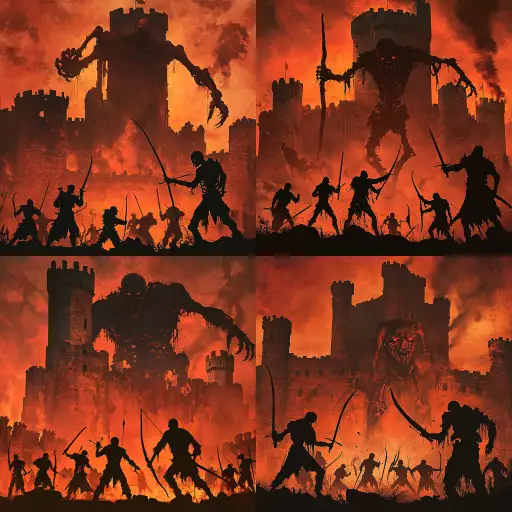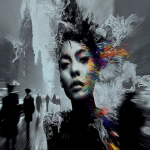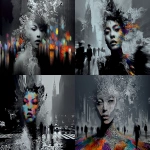Explore the Best AI Image Gallery

Quantum Leap: Unlocking Creativitys Potential with Quantum Computing
The realm of creativity is on the cusp of a paradigm shift, driven by the unprecedented capabilities of quantum computing. This revolutionary technology, harnessing the principles of superposition and entanglement, promises to transcend the limitations of classical computing, unlocking new dimensions of artistic expression, design innovation, and storytelling.
While still in its nascent stages, quantum computing has already begun to tantalize creative minds with its potential. Imagine artists generating mesmerizing visual patterns through algorithms that simulate quantum phenomena, composers crafting symphonies guided by the intricacies of quantum interactions, or architects designing structures inspired by the self-organizing principles of nature at the quantum level.
Quantum Fueling Artistic Exploration
The power of quantum computing lies in its ability to process vast amounts of data and perform complex calculations at speeds unimaginable with conventional computers. This opens up a world of possibilities for artists:
- Generative Art: Quantum algorithms can generate unique and intricate art pieces based on predefined parameters or even learn from existing styles to create entirely new artistic expressions.
- Interactive Installations: Quantum sensors can capture real-time data, allowing artists to create immersive installations that respond dynamically to viewer interactions, blurring the lines between observer and participant.
- Personalized Storytelling: Quantum computing could enable the creation of interactive narratives where storylines adapt in real time based on user choices, offering a deeply personalized and engaging storytelling experience.
Quantum Revolutionizing Design Processes
Beyond artistic expression, quantum computing is poised to revolutionize design processes across various disciplines:
- Materials Science: Quantum simulations can help designers explore the properties of novel materials at the atomic level, leading to breakthroughs in fields like aerospace, construction, and medicine.
- Architecture and Urban Planning: Quantum algorithms can optimize building designs for energy efficiency, structural integrity, and even social interaction patterns, shaping smarter and more sustainable cities.
- Fashion Design: Quantum-powered simulations could enable designers to experiment with new fabrics, textures, and garment structures, pushing the boundaries of fashion innovation.
Navigating Ethical Considerations
As quantum computing becomes increasingly integrated into creative fields, it is crucial to address the ethical implications:
- Bias and Fairness: Quantum algorithms can inherit biases present in the training data, potentially leading to unfair or discriminatory outcomes in creative applications.
- Intellectual Property: The ownership and attribution of creative works generated by quantum algorithms raise complex legal and philosophical questions.
- Access and Equity: Ensuring equitable access to quantum computing resources is essential to prevent a widening gap between those who can leverage its potential and those who cannot.
The Future of Creativity in the Quantum Age
Quantum computing holds immense promise for reshaping the creative landscape. While challenges remain, the future of creativity lies at the intersection of human imagination and quantum ingenuity. Embracing this convergence will unlock a new era of artistic expression, design innovation, and storytelling, pushing the boundaries of what is possible and enriching our world in profound ways.



](https://images.ai-img.art/thumbnails/150/847809c77ca9a73b68bc190e6efb06fec87157685a243730d5a66a403b0e6e10.webp)








](https://images.ai-img.art/thumbnails/150/ff09e32d2be011c0dd785984c5c1e47839ce551a31da1bde242860b30df2aa30.webp)




](https://images.ai-img.art/thumbnails/150/bd056a4718c27444e064198762f8dc8ffa1f74f1afd7dcda8d5cb8b142797d6e.webp)

](https://images.ai-img.art/thumbnails/150/a3ed6513a6661aa3ee46e0c2924d1e8888854e91d8908de39db5590dc41f8d8f.webp)











](https://images.ai-img.art/thumbnails/150/685ae68cfab93a7e59a71206867b060c45bd6fd3cd561c4fe60fca514b09c5f8.webp)


](https://images.ai-img.art/thumbnails/150/7cf5a08238f29c821f52bb4f63db48af0b7f633ff3b9f7253074d78ced9ff6f6.webp)







](https://images.ai-img.art/thumbnails/150/0ba0be922ab76af53f75ab90126ae2b18a600ee3b96941e8ab897a9f10594e5a.webp)
](https://images.ai-img.art/thumbnails/150/2ebdeb4f7db35100e5be5de9bc3e533a40d14e5feedefd7ffc586524a0f3ba8c.webp)





